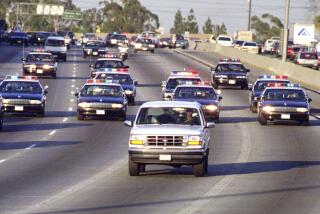A Yellow Truck: An Image for the Ages
- Share via
Pictures may be overrated as broad metaphors, the universes they capture not always matching ones existing beyond the lens. Or perhaps not.
“There are the chads, takin’ a trip!” proclaimed Fox News Channel anchor Shepard Smith on Thursday about the latest convoy of the century.
No, not O.J. Simpson hunched over in a white Ford Bronco. Instead, those chads, packed inside a yellow truck.
If one continuous TV picture were ever worth a thousand sound bites, it was this live chopper’s-eye-view of a highway in Florida where a Ryder rental, fronted and trailed by carloads of sheriff’s deputies, media and observers from the Democratic and Republican parties, carried 462,000 Palm Beach County ballots in gray metal boxes north to a courthouse in Tallahassee.
Where no one could say if they even would be counted.
The entire nation wasn’t watching, as it was in 1994, when Simpson and his pal Al Cowlings stayed just ahead of pursuing squad cars en route to his swanky Brentwood estate on Rockingham Avenue, a slow-speed chase emblematic only of a single bizarre murder case in which uncertainties would linger indefinitely.
Only the 24-hour cable news channels gave Thursday’s yellow truck much attention. Yet how rich, how appropriate, how symbolic its journey was of the fantastical aura of a presidential election that for several weeks now has been freeze-framed inside a dark tunnel of court hearings, partisan speeches and photo ops, with no one knowing whether Republican George W. Bush or Democrat Al Gore ultimately would come through.
And scheduled to hit the road today, making TV pulse-beats pound like tom-toms, are the 654,000 ballots from Miami-Dade County, 10,000 of which Gore wants counted.
What are pictures themselves, if not wormholes through which time tourists cross to one galaxy of human experience from another? History often defines these experiences by their dominant images, whether Dorothea Lange’s 1936 photo of a migrant mother and her children in California during the Depression to newsreels of stacked Holocaust victims and the luckier living cadavers greeting Allied troops liberating them from Auschwitz and other death camps at the end of World War II.
In television, which rarely pauses for thought while running through its Rolodex of visual history, dominant images nearly always capture the disparaging sadness of human behavior instead of the sheer bliss of living. Witness Rodney G. King’s savage beating by Los Angeles cops, shotgun-blasting Daniel V. Jones leaving his brains on a freeway overpass or even the repetitive cranking up of that lipsticked, rouged-up, blond-curled little cowgirl, JonBenet Ramsey.
Which images will Americans see as this historic election’s signature?
Will they be this week’s propagandizing photo ops unleashed by the Bush and especially the Gore crowds as part of a tenacious public relations battle to win public favor, their effortless access affirming just how easy it is to manipulate media that want to be manipulated?
Most of Gore’s time before the camera this week was gratuitous, granted to him in part because he filled space and surely also out of fear that denying him the lens when he wanted it might relaunch charges of pro-Bush bias. And please, when Gore’s running mate, Joseph I. Lieberman, emerges from the White House bearing an attack on the GOP candidate’s brother, Florida Gov. Jeb Bush, must the news channels carry it live as if it were a major address?
Has there ever been anything more transparently camera-tailored, moreover, than Bush’s meeting at his ranch Thursday with retired Gen. Colin L. Powell, rumored to be his choice as secretary of State? It clearly was designed to join the two in the public eye. Although he clearly had nothing to say to the cameras, Bush said it anyway, as still cameras clicked noisily in the Texas sun. Holograms have delivered more substance. And Powell’s comments were about as thin.
It was all rehearsed as “part of an effort to portray a Bush presidency as a fait accompli,” reported CNN’s Jeanne Meserve. Then why carry it live, if at all, as CNN, MSNBC and Fox did? Or excerpt any of it, as evening newscasts did?
Not that this symbiotic process joining media and newsmakers hasn’t existed--at times to the public’s disservice--since the genesis of journalism, just as the camera’s potential to manipulate and be manipulated arrived with the inception of the lens.
Thursday’s traveling ballots provide a more defining image of this election, though. What better picture for a time capsule to instruct future generations than one showing a truck on a mission of possible futility? This time the living cadavers are us.
More to Read
The complete guide to home viewing
Get Screen Gab for everything about the TV shows and streaming movies everyone’s talking about.
You may occasionally receive promotional content from the Los Angeles Times.






